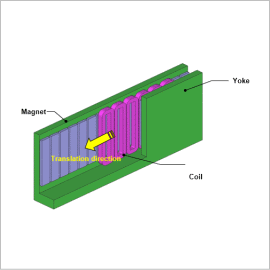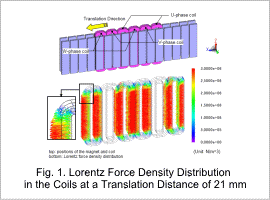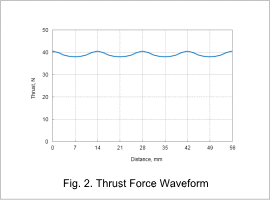*Please prepare a license ID and password for the license administrator.
*It is different from the service for JMAG WEB MEMBER (free membership). Please be careful.
Overview

Linear motors are widely used for carrier devices and machine tools because of their high-speed performance, high acceleration and deceleration, and accurate positioning. Among them there is a type of motor called a coreless linear motor. Coreless linear motors generally have a smaller thrust force than core linear motors, but they do not produce cogging, so they only have a small amount of thrust variation. They are used for linear motor stages and electronic packaging machines to make use of this property.
Because the thrust variations in linear motors are small, they can be hard to predict and measure at the design stage. With the finite element method (FEM), it is possible to obtain thrust variations with accuracy even when they are small, as is the case with a coreless linear motor.
In this example, explains how to obtain the thrust variations in a coreless linear motor when it is driven with a three-phase alternating current.
Because the thrust variations in linear motors are small, they can be hard to predict and measure at the design stage. With the finite element method (FEM), it is possible to obtain thrust variations with accuracy even when they are small, as is the case with a coreless linear motor.
In this example, explains how to obtain the thrust variations in a coreless linear motor when it is driven with a three-phase alternating current.
Lorentz Force Density Distribution

The Lorentz force density distribution at a translation distance of 21 mm is shown in Fig. 1. The Lorentz force is generated by the magnet’s magnetic field when electricity flows through the coil. The strength of the Lorentz force is determined by the current value and the strength of the magnetic field. The direction of the Lorentz force is determined from the direction of both the current flow and the magnetic field.
When the translation distance is 21 mm current only flows through the U-phase and W-phase coils, so the Lorentz force density gets higher in the places in those coils that face the magnets. The Lorentz force occurs in the translation direction, becoming the thrust force.
When the translation distance is 21 mm current only flows through the U-phase and W-phase coils, so the Lorentz force density gets higher in the places in those coils that face the magnets. The Lorentz force occurs in the translation direction, becoming the thrust force.
Thrust Force

The thrust force waveform is shown in Fig. 2. Because there is no cogging the thrust variations are small, comprising about 6% of the average thrust force.


